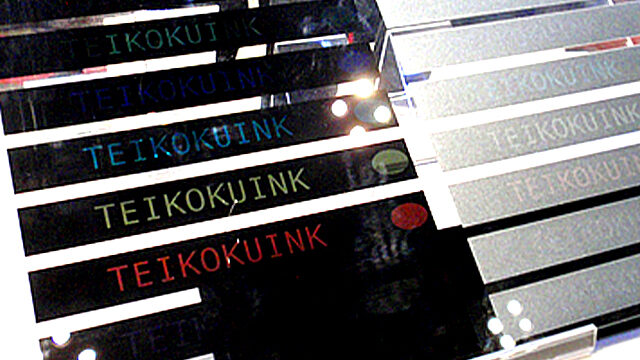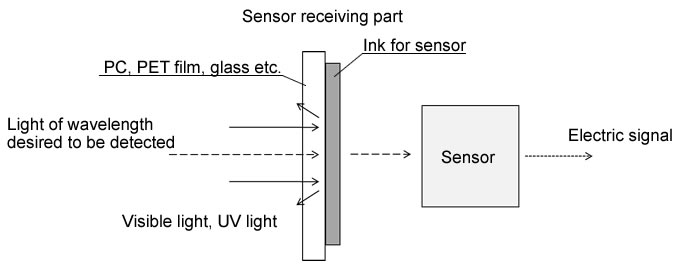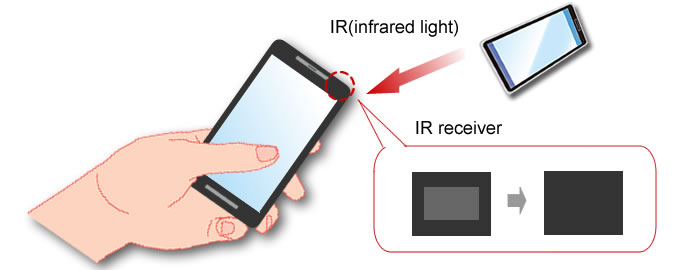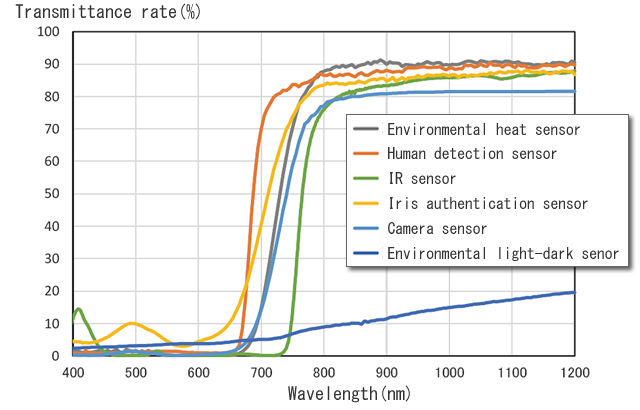Improvement of both sensing function and designability
Ink for sensor
Good news to those who in charge of product development that uses sensing functions such as automation and security.

We introduce ink for sensor (IR transmittable ink) that transmits only light which should be detected and supports sensor improving its accuracy and also it enables to seek designability at the same time.
1. What is ink for sensor (IR transmittable ink) ?
Principle of ink for sensor used for decoration at sensor receiver parts
Ink for sensor (IR transmittable ink) is the ink that transmits only light of wavelength (infrared ray, etc.) that sensor desires to detect in the light radiated to printed ink layer and blocks other lights (visible light or UV light) causing malfunctions. Thanks to this ink for sensor, you can freely design using various colors and improve accuracy of sensing function at the same time.

Seamless design is possible by using ink for sensor (IR transmittable ink).

2. Excellent function of ink for sensor
Ink for sensor enables both improvement of sensor performance and designability
- Adjustment of wavelength of transmitted light and its transmittance rate:
Preventing malfunction of the sensor by preventing intrusion of unintended wavelength light so that sensing accuracy is improved. - Improvement of resistance of light receiving part and prevention of diffused reflection:
Excellent resistance and smoothness (leveling) of printed ink layer can reduce malfunction factors of the sensor such as diffused reflection. - Free design to sensor part:
It is possible to emphasize or conceal the sensor part. Application range such as security use will expand.
Sensor application and corresponding ink function
Depending on sensor application, it can be used by setting transmittable wavelength and functionality freely.
| Application | Applicable Ink | Application and required functions |
|---|---|---|
 |
Ink for IR sensor (also available in white (with restriction)) |
Application: Remote controller, IR data transfer Requirement: Wavelength of light at 850 nm is the center. Transmittance rate is 50% or more |
 |
Ink for motion sensor | Application: Detect the presence or absence of people and obstacles in the vicinity. IR transmitter and receiver are one set. Requirement: 80% or more at 940 nm, 950 nm, 1200 nm. Transparency by low haze and low reflection |
 |
Ink for fingerprint authentication sensor | Application: Irradiate infrared ray on the finger and read its reflected light. Requirement: More than 80% at 940 nm, 950 nm, 1200 nm |
 |
Ink for iris authentication sensor | Application: Apply a specified lamp on the face and detect light reflected from eyes. Requirement: More than 80% at 940 nm, 950 nm, 1200 nm |
 |
Ink for camera sensor | Application: Camera focusing Requirement: 850 nm is the center and more than 75%. Transparency by low haze and low reflection |
 |
Ink for thermal sensor of environment | Application: Sensor detects heat of environment in the vicinity Requirement: More than 85% at 940 nm, 950 nm, 1200 nm |
 |
Ink for sensor corresponding brightness/ darkness environment (ALS (Ambient Light Sensor)) |
Application: Detect environmental brightness and darkness and adjust brightness of ambient electricity and screen. Requirement: 2% to 10% at 550 nm, same transmittance rate at 400 nm to 700 nm. Not transmitted in IR range. |
Ink for sensor depending on the substrates
Ink for sensor can be set depending on substrates to be printed and application.
Please consult us about the use of Ink series other than substrates and recommend inks which aren’t indicated below.
| Substrate | Recommended ink | Product features |
|---|---|---|
| PET, PC, PMMA | MIX-HF | High transparency and excellent leveling performance. Isophorone-free |
| Glass | IRX-HF | 2 pack type ink. High transparency and excellent leveling performance. Isophorone-free |
3. Transmitted light chart of each application and application examples
Chart of transmitted light wavelength and transmittance rate of each application.
The chart shows adjustment examples of wavelength of transmitted light and transmittance rate for various kinds of sensors.

Application example for fingerprint authentication sensor
Design with sense of unity has been realized by making light reception part and other parts same color.

Example where visible light was selectively transmitted (example of concealing print)
The function which makes yellow color of visible light transmit to seamless gray design is added. (Backlight is white color)

- Related technology information
- Related event information
- Related inks

